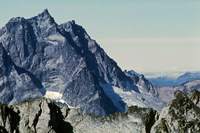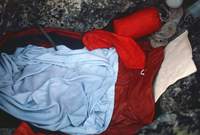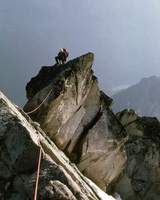North Ridge of Mount Stuart
2–4 July 1970

This picture was taken 18 April 1971 from Eightmile Mountain;
the snow helps emphasize features important for planning a climb.
High-angle rock sheds snow,
while lower angles
(and likely easier climbing)
retain snow.
In this case,
the access to the crest of the ridge begins at some snow patches to the
right of the ridge and continues out of sight up a narrow gully.
However,
some areas with snow can be quite dangerous.
The narrow glacier to the left of the ridge is the
Ice Cliff Glacier;
Mark Weigelt
(one of my instructors in the climbing courses)
was killed in the snow-filled gully above the glacier in October 1972.
Mount Stuart is part of the
largest granite monadnock
in the contiguous 48 states.
The North Ridge route is one of the
Fifty Classic Climbs of North America
and is also described in
Selected Climbs in the Cascades v1.
The route was first climbed in September 1956.
We took the original route from Ingalls Lake,
over a small pass and across the Stuart Glacier to access the ridge about
halfway up
(red line).
The ridge was climbed from its base in 1963,
but most climbers still access the ridge via the original route.

This picture was taken in early Fall from the Enchantment Lakes;
it is a better representation of the condition of the mountain at the time
we climbed it.
Dave Christensen and I hiked in to Ingalls Peak on 2 July to do some
reconnaissance for leading future climbs with the climbing courses.
We must have looked out of place with our ice axes since there is no
snow on the southern exposures we were investigating.
We spent the night at Ingalls Lake and got a leisurely start the next
day,
planning to bivouac somewhere on the ridge.
Crossing over the pass between Ingalls and Stuart,
we began our traverse of the Stuart Glacier with only our ice axes to
protect us on the steep, icy slopes.

We transitioned from the glacier to the ridge at about 4PM and climbed
an easy diagonal system of cracks to the ridge crest.
Not long after reaching the ridge crest,
we each found niches for a bivouac and settled in for the night at about
8,500 feet.
We were seeing some lightning to the northwest and were concerned that
we would be in a vulnerable place if the storm headed our way,
but we were committed at this point.
We hoped that the
red sky at night
adage held.

The next day dawned clear and beautiful.
We had counted on warm weather,
and all I needed for the night was my
bivouac sack,
sleeping bag liner,
small
Ensolite
pad and the extra clothing I had brought.
The night had been so warm we were bothered by mosquitoes all night.
We had pellets we could burn to heat water for the small dehydrated
meals we packed for dinner and breakfast.

We continued our climb up the ridge,
starting at about 7:30AM.
Much of the ridge is easy enough to climb with one's rucksack on,
but the difficulty increases as one approaches the summit.
Just before the most difficult section,
we had to rappel before continuing our upward progress.

Near the summit were some leads where we shed the rucksacks and hauled
them up after we had climbed a difficult pitch.
The route gets more vertical as one approaches the summit,
so hauling packs is practical,
but it does mean that one often has to keep the pitches shorter than a full
rope length.
I drew the most difficult pitch–
about 30 feet of 5.6 climbing.

After 22 pitches,
we reached the summit at about 1PM.
It was still early enough to do more and we had food for another day,
so I wanted to traverse to Sherpa Peak and climb the
balanced rock,
but Dave needed to get home and could not risk the extra day
(at least)
in the mountains such an endeavor would require.
Getting to Sherpa would mean traversing nearly one mile of class 3,
4 and 5 ridge.
Besides,
we were low on water and would have to exist on what snow we could eat.
We descended via
Ulrich's Couloir,
the easiest route up and down the mountain,
requiring no belays for the careful climber.
We spent a comfortable night at Ingalls Creek,
in spite of temperatures in the mid 30s;
at least the mosquitoes did not bother us!
A short hike the next morning got us to the car.






